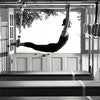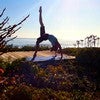Correcting Shoulder Carriage Part I
Part 2:
I found that I needed to get out of the tug-o-war between the internal rotators (the beefier triad of teres major, lat and pec major) and the external rotators (infraspinatus, posterior delt and teres minor). What has worked for me (and others I have worked with) is my personal Switzerland of the region, the cervical extensors! Why? I have found that when the neck is cued to extend (and the chin remains retracted and neutral in orientation), the shoulders fall quietly into a beautiful position that feels very natural. Ahhh. And this cue works outside the studio for me as well. Let me know what has worked for you ?
I found that I needed to get out of the tug-o-war between the internal rotators (the beefier triad of teres major, lat and pec major) and the external rotators (infraspinatus, posterior delt and teres minor). What has worked for me (and others I have worked with) is my personal Switzerland of the region, the cervical extensors! Why? I have found that when the neck is cued to extend (and the chin remains retracted and neutral in orientation), the shoulders fall quietly into a beautiful position that feels very natural. Ahhh. And this cue works outside the studio for me as well. Let me know what has worked for you ?
14 years ago
Thanks Layla - Your ideas are helpful to me as I am constantly trying to help my clients achieve proper shoulder mechanics.
14 years ago
I really liked Ken Gilbert's cue of "expand the chest" as a means for elongating the neck and allowing the shoulders to fall into place rather than be forced into place. It has made such a difference in the outcome than when I say drop your shoulders etc.. I find with my own body the more ease I look for the better the placement. When the ease of allowing my chest to expand doesn't do it, it becomes clear which muscles are restricted and that is where I try to stretch or focus on lengthening.... Thanks Layla!
14 years ago
Thanks for those tips! I've tested it out (firstly on myself lol!) and with a number of clients and it's worked beautifully =)
11 years ago
One thing I've been wondering about as a beginning teacher in training is what to do when it's clear that there are tight fascia involved. I have a suspicion that this is a factor for many people with thoracic kyphosis -- their fascia are just so tight that it can be hard to build the muscles needed to balance out those pesky pecs.
I like these cue suggestions, and I'm going to try them.
I like these cue suggestions, and I'm going to try them.

11 years ago
You need to be a subscriber to post a comment.
Please Log In or Create an Account to start your free trial.














So I recently devoted an entire session on my own, working on understanding where the shoulder tension comes from and how best to release it. I worked on mat, chair and reformer exercises, testing proper shoulder engagement and improper shoulder involvement. I stumbled upon a concept that worked very well, and might work for you or those you train, but I am wanting to hear your favorites...